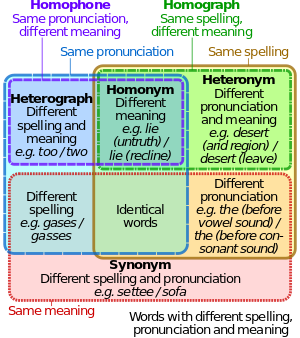Help
Difference between revisions of "Homographs"
m (→Rules) |
m (→Rules) |
||
| Line 7: | Line 7: | ||
# This suffix should hint at the difference between both homographs. | # This suffix should hint at the difference between both homographs. | ||
# The suffix must be consistent and stable, ex: if you start with <code>(noun)</code>, keep that exact convention <u>for all</u> your recordings. If you start with a transcription, keep on that transcription. | # The suffix must be consistent and stable, ex: if you start with <code>(noun)</code>, keep that exact convention <u>for all</u> your recordings. If you start with a transcription, keep on that transcription. | ||
| − | # The suffix is in the same language as the word, ex : <code>red (noun)</code>, <code> | + | # The suffix is in the same language as the word, ex : <code>red (noun)</code>, <code>အနီရောင် (နာမ်)</code> |
# Abbreviations can be used ''if and only'' if well established in the general public, ex: <code>adj.</code>, <code>v.</code>, <code>n.</code> | # Abbreviations can be used ''if and only'' if well established in the general public, ex: <code>adj.</code>, <code>v.</code>, <code>n.</code> | ||
Revision as of 20:18, 12 January 2022

Homographs (same writing) but not homophone (not same pronunciation), aka Heteronym require a suffix to differentiates these audios. The suffix should not be pronounced nor recorded.
Rules
- If one pronunciation is clearly the norm, no suffix is needed
- For equal rank or rare pronunciations, add to that word a suffix within brackets, example:
# word (suffix). - This suffix should hint at the difference between both homographs.
- The suffix must be consistent and stable, ex: if you start with
(noun), keep that exact convention for all your recordings. If you start with a transcription, keep on that transcription. - The suffix is in the same language as the word, ex :
red (noun),အနီရောင် (နာမ်) - Abbreviations can be used if and only if well established in the general public, ex:
adj.,v.,n.
Homographs homophones
Given one language and one speaker, one recording for them all. Even if meaning diverges.
Heteronym (homographs non-nomophones)
The following are homographs non-homophones, the part between brackets is not read aloud in LinguaLibre but is used to distinguish those recordings.
Distinction via semantic synonyms :
# crooked (injured), pronounced and recorded `crookaid` /ˈkrʊkɪd/# crooked (corrupt), pronounced and recorded `crookt` /ˈkrʊkt/
Distinction via pronunciation in a transcription of your choice, here with IPA:
# crooked (/ˈkrʊkɪd/), pronounced and recorded `crookaid` /ˈkrʊkɪd/# crooked (/ˈkrʊkt/), pronounced and recorded `crookt` /ˈkrʊkt/
Distinction via the part of speech :
# excellent (v), pronounced and recorded `excel`# excellent (adj), pronounced and recorded `excellant`
In some language, word can be pronounced and recorded differently if read by a man or woman :
# vert (masculin), pronounced and recorded `ver`# vert (féminin), pronounced and recorded `verte`
In practice
Within your list such as List:mnw/Commons, transform :
# ကစေံ1 # ကစေံ2
into
#ကစေံ (read) #ကစေံ (speak)
You can now record your words, without reading the suffix.
